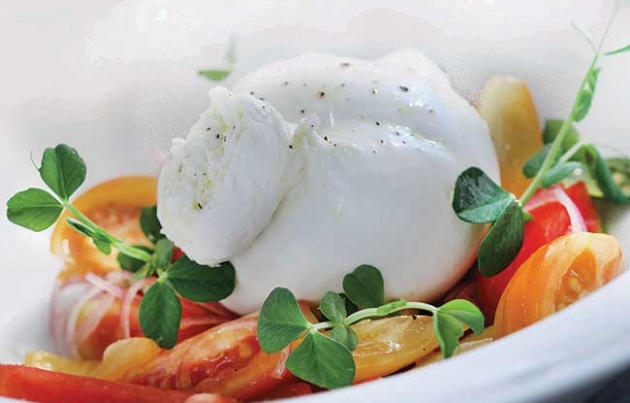Burrata, which means 'buttered' in Italian, gets its name from the rich, thick straciatelli that oozes out of this soft pouch of fresh #cheese filled with thick #cream and #mozzarella scraps.

Puglia, or Apulia as it is known in English, is famous for the beautiful beaches that straddle the region on both sides. Of late however, Puglia is better known around the world as the birthplace of burrata, the trendier, younger cousin of the old favourite, mozzarella. Although mozzarella and Parmigiano Regiano are still the most well-known cheeses to come out of Italy, burrata is quickly catching up.
Burrata, which means ‘buttered’ in Italian, gets its name from the rich, thick straciatelli that oozes out of this soft pouch of fresh cheese. The first ball of burrata is said to have been made on a farm in the Puglian town of Andria in 1920. A few decades later, factories in the area began manufacturing it in order to use up scraps of cheese left over from making mozzarella.
The beginnings of a burrata are quite similar to that of a mozzarella – fresh, warm buffalo milk is curdled using the enzyme rennet. Once the curds form, they are torn into pieces and plunged into hot water. As it softens and coagulates, it is taken out of the water, kneaded and stretched to form what is called pasta filata. Instead of shaping the cheese into a ball, like in the case of mozzarella, it is instead molded into a pouch and filled with a luscious, thick cream (panna) and strands or ‘rags’ of mozzarella (ritagli).
Although like mozzarella, cow’s milk can be used to make burrata, buffalo milk is preferred because of its higher protein content. Buffalo milk is also responsible for lending both mozzarella and burrata their iridescent, white colour.
Chef Satbir Bakshi, Executive Chef at The Oberoi, Mumbai, recalls that his first taste of burrata was in London at a Michelin-star restaurant, The Greenhouse. He instantly took a liking to the cheese, and set out to find a local source as soon as he returned to India. Being a fresh cheese, best consumed within 48 hours of manufacture, it didn’t make sense for him to source it from Italy. His search came to a happy end when he found that Father Michael in Bangalore made burrata and other cheeses in his monastery. One bite of his hand-crafted burrata and there has been no looking back. “When we served buratta in our Italian restaurant, Vetro, we were the first ones to do so in Bombay.” Before long, upscale restaurants all over town started featuring it on their menu. “Indians love creamy cheeses; it’s rare to find an Indian who feels the same way about say, a cheddar or an edam,” he says, when asked about its popularity in India.
Father Michael, who provides cheese to many of the high-end restaurants in the country, has been making burrata for 6 years now. He says that when he started out, it was still a fairly unknown cheese. Having been to Italy where he learned cheese making, he decided to introduce it to the Indian market. When asked what it is that makes his burrata so special, with restaurants ordering up to 15 kilos of it every week, he says it’s the buffalo milk that makes all the difference.
Chef Bakshi tells me that one of the most popular dishes served at Vetro, is one that incorporates burrata with porcini sourced from Italy, served with a herb meringue. More recently however, burrata features on his menu alongside an asparagus sorbet.
Another memorable dish that Chef Bakshi created was one that paired burrata with heirloom tomatoes. Like mozzarella, that sings when eaten with a slice of tomato, burrata does equally well with this pairing – the bright acidity of the tomato cuts through the milky creaminess of the burrata, making it an easy combination to pull off. A few sprigs of basil add another dimension of delicate flavour.
Burrata is a favourite not just here in India, it has caught the imagination of chefs the world over. Celebrity chef, Yotam Ottolenghi, has a Blood Orange and Burrata salad on the menu at his London restaurant NOPI. It features burrata with blood orange, coriander seed and lavender oil, and is one of the most popular dishes at the restaurant. Ottolenghi says, “Customers come to NOPI for this dish alone. We sell about 1,000 each month!”
With its delicate and luxurious flavours, it is easy to see why burrata fits into fine dining menus with ease. However it is equally at home in a domestic kitchen. Those who are yet to experiment with burrata at home will be glad to know that incorporating it into a meal is fairly easy. Tear the soft blobs apart, and toss it into a green salad, or stir into pasta for instant creaminess.
For a low-key dish, squish it onto a piece of toast, season with cracked pepper and enjoy the pleasure of a simple, delicious meal.
Lesser known facts about buratta:
Burrata was a firm favourite with the Shah of Iran who used to fly it in for dinner parties.
Burrata is usually wrapped in asphodel leaves with a top-knot shaped like a brioche. A good way to check if the burrata is fresh is to make sure that the asphodel is a bright green.
Panna, the cream used to make the stracciatella, is made from a thick heavy cream that naturally separates from the milk.
Hi! I am a robot. I just upvoted you! I found similar content that readers might be interested in:
https://www.foodlovers.in/blog/essentials-burrata/
Downvoting a post can decrease pending rewards and make it less visible. Common reasons:
Submit